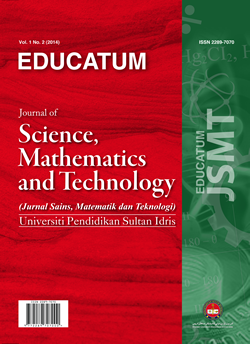Instrument of Understanding Level Test of Newton’s Law Concept: Case Study Flying Fox Ride in Bukik Chinangkiek Edupark, West Sumatera, Indonesia
DOI:
https://doi.org/10.37134/ejsmt.vol8.2.6.2021Keywords:
Understanding Level of Concept, Newton’s Law, EduparkAbstract
Misconception is a misinterpretation of a concept that incompatible with scientists conception. Misconception can be caused by experiences when interacting with natural environment. One of physics concept that is often encountered in everyday life and still a misconception for students is Newton's law concept. Natural learning can help students understand scientific concepts. Using surrounding environment in learning is to make it a learning resource or known as educational park. Physics e-book of Bukik Chinangkiek Edupark, describes the application of Newton's law concept on flying fox rides very well. But, this book only contains an evaluation of student’s knowledge, not accompanied by an evaluation to find out the understanding level of student’s concept. The evaluation of student’s concept understanding is necessary to detect and distinguish the understanding level of student’s concepts, between understand the concept, understand the concept but not sure, misconceptions, and not understand the concepts. Teacher will more easily determine the countermeasures for each student by knowing the understanding level of student’s concepts. Edupark-based test instruments are required to determine the understanding level of student’s concepts in Newton's law based on flying fox ride in Bukik Chinangkiek Edupark. This is Research and Development (R&D) type of research using Plomp model that consist of three stages; 1) preliminary research; 2) prototyping phase; 3) assessment phase. This research was conducted until prototyping phase. This instrument developed in multiple choice test form with open reasoning accompanied by modified Certainty of Response Index (CRI). This research data were processed by descriptive and statistical analysis. The test instrument has been tested for the validity of content and empirically produces 14 valid items. The instrument is declared reliable with an index 0.79. The results of understanding level of student’s Newton's law concepts analysis showed 17.83% of students are in understand the concept category, 3.33% of students are in understand the concept but not sure category, 45.33% of stundents are in misconceptions category, and 33.50% of students are in not understand the concept category.
Downloads
References
Severinus, D. (2013). Pembelajaran Fisika Seturut Hakekatnya serta Sumbangannya dalam Pendidikan Karakter Siswa. Seminar Nasional 2nd Lontar Physics Forum 2013: 5.
Suparno, P. (2005). Miskosepsi dan Perubahan Konsep dalam Pendidikan Fisika. Jakarta: PT Grasindo.
Tayubi, Y. R. (2005). Identifikasi Miskonsepsi Pada Konsep-Konsep Fisika Menggunakan Certainty of Response Index (CRI). Mimbar Pendidikan, 24(3): 5.
Zulvita, R., Halim, A., & Elisa. (2017). Identifikasi dan remediasi miskonsepsi konsep hukum newton dengan menggunakan metode eksperimen di man darussalam. Jurnal Ilmiah Mahasiswa (JIM) Pendidikan Fisika, 2(1): 129.
Lestari, N. V., & Rifai, H. (2020). Preliminary Analysis of Bukik Chinangkiek Edupark’s Potential as a Learning Resource for Physics in Senior High School at X Koto Singkarak Solok , Indonesia. The 2nd International Conference on Research and Learning of Physics: 5-38. https://doi.org/10.1088/1742-6596/1481/1/012049
Rahayu, A. Y., Syuhendri, S., & Sriyanti, I. (2019). Analisis Pemahaman Konsep Mahasiswa Pendidikan Fisika Universitas Sriwijaya pada Materi Gravitasi Newton dengan Menggunakan NGCI Dan CRI Termodifikasi. Jurnal Eksakta Pendidikan, 3(1): 65.
Rifai, H., Yohandri, Sari, D. P., & Emafri, W. (2019). Pengintegrasian Wahana Permainan Wisata Alam Ngarai Sianok dan Wisata Buatan MiFan Water Park Padang ke dalam Materi Fisika. Jurnal Eksakta Pendidikan, 3(2): 109.
Yunita, R. A., & Rifai, H. (2020). Preliminary Analysis of Edupark Sarasah Kajai Waterfall , Indonesia as a Learning Resources of Works and Energy. Journal of Physics: Conference Series, 1481(1), 1–7. https://doi.org/10.1088/1742-6596/1481/1/012047
Lestari, N. V., & Rifai, H. (2020). E-book Edupark Fisika Bukik Chinangkiek Singkarak Untuk SMA/MA & Sederajat dengan Pendekatan Saintifik. Padang: CV Berkah Prima. https://scholar.google.com/citations?user=z4nEi2QAAAAJ&hl=id
Adodo, S. O. (2013). Effects of Two-Tier Multiple Choice Diagnostic Assessment Items on Students’ Learning Outcome in Basic Science Technology (BST). Academic Journal of Interdisciplinary Studies, 2(2): 202. https://doi.org/10.5901/ajis.2013.v2n2p201
Hasan, S., Bagayoko, D., & Kelley, E. L. (1999). Misconceptions and the certainty of response index (CRI). Physics Education, 34(5): 295. https://doi.org/10.1088/0031-9120/34/5/304
Hakim, A., Liliasari, & Kadarohman, A. (2012). Student Concept Understanding of Natural Products Chemistry in Primary and Secondary Metabolites Using the Data Collecting Technique of Modified CRI. International Online Journal of Educational Sciences, 4(3), 544–553.
Safriana, & Fatmi, N. (2018). Analisis Miskonsepsi Materi Mekanika pada Mahasiswa Calon Guru Melalui Force Concept Inventory dan Certainty of Response Index. Jurnal Pendidikan Sains Indonesia, 06(02), 90–94. https://doi.org/10.24815/jpsi.v6i2.11897
Plomp, T., Nieveen, N., Akker, J. van den, Bannan, B., & Kelly, A. E. (2013). Educational Design Research Part A: An Introduction. In T. Plomp & N. Nieveen (Eds.), Educational Design Research. Netherlands Institute for Curriculum Development (SLO): 19. https://doi.org/10.1007/978-1-4614-3185-5_11
Rochmad. (2012). Desain Model Pengembangan Perangkat Pembelajaran Matematika. Kreano: Jurnal Matematika Kreatif-Inovatif, 3(1): 65.
Sugiyono. (2012). Metode Penelitian Kuantitatif Kualitatif dan R&D (17th ed.). Bandung: ALFABETA.
Riduwan, & Sunarto. (2012). Pengantar Satistika untuk Penelitian: Pendidikan, Sosial, Komunikasi, Ekonomi, dan Bisnis (Akdon (ed.); 5th ed.). Bandung: ALFABETA.
Arikunto, S. (2009). Dasar-Dasar Evaluasi Pendidikan. Jakarta: Bumi Aksara.
Aprilia, N., Susilaningsih, E., Priatmoko, S., & Kasmui. (2020). Desain Instrumen Tes Pemahaman Konsep Berbasis HOT dengan Analisis Model Rasch. Journal of Chemistry In Education, 9(2): 2.
Muna, I. A. (2015). Identifikasi Miskonsepsi Mahasiswa PGMI pada Konsep Hukum Newton Menggunakan Certainty of Response Index (CRI). Cendekia, 13(2): 312.
Giancoli, D. C. (2001). Fisika (5th ed.). Jakarta: Erlangga.
Nasafi, I. (2018). Pengembangan Instrumen Tes Diagnostik Pilihan Ganda Tiga Tingkat Untuk Mengidentifikasi Miskonsepsi Siswa pada Materi Hukum Newton. Semarang: UIN Walisongo: 56.





